Trinity Lutheran Church has a rich history. Within the past 5 years, we have become a
historical landmark for the city of St. Petersburg. Read on to learn more about the creation of our church...
ONE HUNDRED YEARS OF TRINITY HISTORY
1911-2011
Trinity History ~ from the beginning
Along with the eighteen charter members and more than five thousand members whose dedication and sacrifice
have contributed to the development and progress of Trinity Lutheran Church, we give God the glory for the 100 years of blessings
he has bestowed upon us.
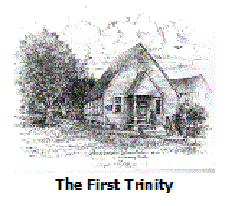 On March 26, 1911, the first Lutheran congregation on the West Coast of Florida was organized with eighteen charter members,
and it was named Trinity. Services were held in a room over a garage on the corner of Second Avenue and Second Street South.
Later, a chapel and parsonage were built three blocks west of the garage quarters. By 1920, Trinity needed to relocate to
a larger home. On March 26, 1911, the first Lutheran congregation on the West Coast of Florida was organized with eighteen charter members,
and it was named Trinity. Services were held in a room over a garage on the corner of Second Avenue and Second Street South.
Later, a chapel and parsonage were built three blocks west of the garage quarters. By 1920, Trinity needed to relocate to
a larger home.
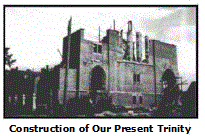 The original chapel and parsonage were sold and the present location was selected as the site for the new sanctuary. The first
service was held in the nave on October 24, 1924. In September 1925 the stained glass windows, made in Munich, Germany
by Emil Frei Art Glass were placed, and a pipe organ built by the Pilcher Company was installed also that year. In February
1939, the Rev. Henry V. Kahlenberg was called to Trinity and he began a vigorous program which focused primarily on reduction
of the congregation's large debts. The indebtedness of over $150,000 was gradually reduced and on April 8, 1945, a service
of dedication and mortgage burning was held. The original chapel and parsonage were sold and the present location was selected as the site for the new sanctuary. The first
service was held in the nave on October 24, 1924. In September 1925 the stained glass windows, made in Munich, Germany
by Emil Frei Art Glass were placed, and a pipe organ built by the Pilcher Company was installed also that year. In February
1939, the Rev. Henry V. Kahlenberg was called to Trinity and he began a vigorous program which focused primarily on reduction
of the congregation's large debts. The indebtedness of over $150,000 was gradually reduced and on April 8, 1945, a service
of dedication and mortgage burning was held.
In the 1930's, money was very tight and the mortgage was sizeable. To assist in making the mortgage payments,
many women of the church volunteered to cook and serve meals to civic clubs which met in the space below the church nave.
Those who were served were charged 25¢ a meal and thereby the ladies earned sufficient "profit" to keep the banker at bay.
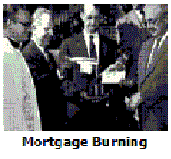 Trinity was growing, and the Sunday School overflowed to the basement, the pastor's office, church balcony, the sanctuary
- and even outdoors at times. Plans were approved in 1951 to erect a parish building at a cost of $125,000. The mortgage
was burned in 1956, just five years after its completion. Trinity was growing, and the Sunday School overflowed to the basement, the pastor's office, church balcony, the sanctuary
- and even outdoors at times. Plans were approved in 1951 to erect a parish building at a cost of $125,000. The mortgage
was burned in 1956, just five years after its completion.
Shortly after this period, air conditioning was installed throughout the church and parish building. To provide
needy access to church services, an Otis elevator was installed with the cost paid for by a bequest.
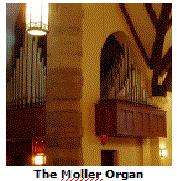 In 1968 Trinity did extensive remodeling of the sanctuary. The present pipe organ was built by the M.P. Moller Company of
Hagerstown, Maryland and installed in 1968. The initial financial gift for the organ was made by the Knies family. When the
organ was dedicated on November 17, 1968, it was christened the Knies-Jamerson Memorial Organ in memory of this gift and of
R. Walton Jamerson, Jr., the beloved organist and choirmaster who was tragically killed in an automobile accident in 1965. In 1968 Trinity did extensive remodeling of the sanctuary. The present pipe organ was built by the M.P. Moller Company of
Hagerstown, Maryland and installed in 1968. The initial financial gift for the organ was made by the Knies family. When the
organ was dedicated on November 17, 1968, it was christened the Knies-Jamerson Memorial Organ in memory of this gift and of
R. Walton Jamerson, Jr., the beloved organist and choirmaster who was tragically killed in an automobile accident in 1965.
The various sounds on pipe organs have different names: diapason, bourdon, etc. Trinity’s pipe organ
has a sound (a rank of pipes) with a name not shared by any other organ in the world: a Wasserflöte. It was named for
Trinity’s organist, Bill Waters. (Wasser is the German word for Water.)
Parking space was at a premium and to provide more, Trinity first purchased the home located next to the
parish building. The home was razed and the lot paved. Two additional properties across Fifth Street were acquired for parking
in 1982 and 1984. The "Assure Our Future Campaign" was instituted in 1984 to provide the monies to pay the costs of the latest
and the largest parking area.
Trinity, the first Lutheran church on the West Coast of Florida, helped in the beginnings of new Lutheran
missions, including St. Andrew Lutheran Church, Christ Lutheran Church, and the Lutheran Church of the Holy Comforter in this
area. From 1941 through 1943, Pastor Kahlenberg conducted services for a group of Lutherans in Bradenton. This
church was organized in 1945 as Trinity Lutheran Church. Trinity was also privileged to play a role in the development
of Redeemer Lutheran Church. 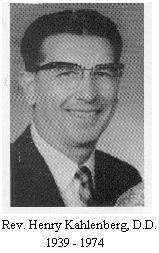
The Florida Synod office was quartered at Trinity for almost eight years. Two rooms off the balcony were
their offices.
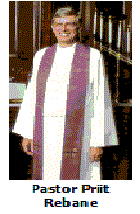 On August 16, 1974, after more than thirty-five years of service, the Rev. Henry V. Kahlenberg passed away. One year later,
Trinity called the Rev. Priit Rebane to be its new pastor. Pastor Rebane’s family had been sponsored by Trinity to come
to St. Petersburg as displaced persons from Estonia. Pastor Rebane's father, the late Rev. Hans Rebane served Trinity for
a period of two years. The Rev. Herman L. Gilbert began his duties as Trinity's Pastor of Visitation in 1976. On August 16, 1974, after more than thirty-five years of service, the Rev. Henry V. Kahlenberg passed away. One year later,
Trinity called the Rev. Priit Rebane to be its new pastor. Pastor Rebane’s family had been sponsored by Trinity to come
to St. Petersburg as displaced persons from Estonia. Pastor Rebane's father, the late Rev. Hans Rebane served Trinity for
a period of two years. The Rev. Herman L. Gilbert began his duties as Trinity's Pastor of Visitation in 1976.
Trinity has supported missionaries since 1948. We currently contribute to Pastor John Lunn in his ministry
in India. Pastor Lunn has visited us several times to share his experiences. He is both a pastor and a registered nurse,
and established a form of Hospice program in India.
Trinity Lutheran Church established the Lutheran Apartments in downtown St. Petersburg, and Lutheran Residences
in South Pasadena. These buildings provide 400 units for people from age 62, whatever their economic, racial or creedal background.
Over the years, since 1950, Trinity has been actively involved in assisting the settlement of displaced persons
and refugees. In 1982, Trinity undertook the sponsorship of a young Polish refugee family. Later, Trinity also helped resettle
a Bosnian family from Sarajevo and several Liberian families who were refugees from the civil war in that African country.
Among those members going into the ordained ministry from Trinity and Redeemer are Pastors J. Pierce Evans,
Paul Stolz, Richard Bauman, Linda Nelson, and Richard Webber.
Over the years, Trinity’s music program enjoyed great strength, especially under the leadership of
William Waters and Thomas Hall.
Following the death of Pastor Gilbert and the resignation of Pastor Rebane in 1991, Trinity moved on with
a dedicated and close-knit church staff – Pastor Patricia Large, program coordinator Linda Nelson, office manager Cappy
Phipps and organist Thomas Hall.
Redeemer History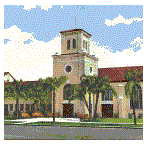
The "Pink Church" at 4355 Central Avenue will long be remembered by St. Petersburg. On January 15
1950, the congregation of Redeemer Lutheran church was organized with 72 members, a congregation of the Augustana Lutheran
Church. The church included many members with Swedish background.
The Board of Home Missions of the Augustana Church oversaw the birth of Redeemer. The first services were
held in Selama Grotto. Redeemers’ first pastor came directly from the seminary and was newly married. The Bensons were
without furnishings and Trinity’s pastor organized an in-gathering of household goods to get them started in their new
home.
 Groundbreaking for the first 2 units was on August 15, 1950 with dedication on January 14, 1951. Pastors from Trinity participated
in the groundbreaking for the Redeemer church structure, including Pastor Hans Rebane. Redeemer’s first service was
held in the church parish hall on Dec. 3, 1950 where there was no floor or roof. Groundbreaking for the first 2 units was on August 15, 1950 with dedication on January 14, 1951. Pastors from Trinity participated
in the groundbreaking for the Redeemer church structure, including Pastor Hans Rebane. Redeemer’s first service was
held in the church parish hall on Dec. 3, 1950 where there was no floor or roof.
 Property along First Avenue North was acquired for temporary classrooms. During the first five years, membership grew to 400.
A parsonage was built on the property. When its use changed, it was later named Luther House. In May 1956, the educational
building was added to the first units. In May 1957, plans were next to build sanctuary. On October 2, 1960, the first services
were held in the sanctuary. By that time, Sunday school membership was at 200. Property along First Avenue North was acquired for temporary classrooms. During the first five years, membership grew to 400.
A parsonage was built on the property. When its use changed, it was later named Luther House. In May 1956, the educational
building was added to the first units. In May 1957, plans were next to build sanctuary. On October 2, 1960, the first services
were held in the sanctuary. By that time, Sunday school membership was at 200.
Redeemer oversaw many active programs over the years. A seminary intern program over the years guided future
pastors. The Women’s Missionary Society, Dorcas Society, Lutheran Church Women, Co-Weds, and Luther League were some
of the groups in place at Redeemer.
Redeemer’s 40th anniversary was celebrated on February 4, 1990, their 50th in
December of 2000.
The church rented classroom space to two private schools, the Wellington school in 1974, and in June of 1996
Brighton Preparatory School rented space in the facility.
The congregation held their final Sunday in the Redeemer sanctuary on May 25, 2003. Memories were shared
and then boxes would be packed for their move to Trinity.
Unification
In the last two decades, declining membership and finances occurred for both
churches. In 2001, Trinity and Redeemer began sharing a pastor. Through a "cooperating" agreement, Pastor Van Horne became
responsible for Redeemer as well as for Trinity.
In 2003, Redeemer Lutheran sold its church to Gateway Christian Center. The Unification Sunday celebration happened on
June 1, 2003. The event made local headlines, citing a "June Wedding." Musical fanfare with a unified choir marked the joining
of the two congregations. With the unification, Judy Bates joined Trinity’s musical staff and Kris Wright became a part-time
Associate in Ministry. A new church was made, combining the faith, talents and hard work of those uniting.
Today at Trinity
During the last several years Trinity has opened its facilities to several community service organizations. Currently,
several groups meet each week in our facility: three AA and NA groups meet weekly. "Loaves and Fishes," the breakfasts for
the homeless are served every Saturday morning. At times, attendance reaches over 200. For the 2010, Christmas Day gathering,
Trinitarians provided practical gifts of food and clothing for all attendees. "Caring Callers" assist our pastors by visiting
the shut-ins and bringing communion. Kingdom Kids, under the leadership of Lisa Napolitano, have weekly lessons and service
projects. The choir’s numbers have grown. A bell choir plays most services, accompanying the psalms. The Altar Guild
is always on top of the worship needs of the day.
"Pairs and Spares" is a monthly luncheon get-together for members. Two groups of Women of the Evangelical Lutheran Church
(WELCA) meet: the Esther and Band of Angels circles. The group has hosted the area-wide WELCA annual meetings. The "Sew N
Sews" gather every Wednesday to make their beautiful quilts, which are donated to needy farm workers in southern Florida.
Also, during the Advent season, members donate new blankets and food which are delivered to the workers before Christmas.
Weekly coffee hours are served after the service, under the supervision of Virginia Rooker, kitchen chair. Many meals are
served on holidays, and birthday cake is provided each month.
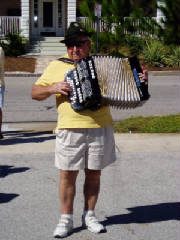 Our Oktoberfest celebration is offered every year as a gift to the neighborhood, an opportunity for members to serve and unite
with others. Good food, German dancers, and music are always worth the visit. Our Oktoberfest celebration is offered every year as a gift to the neighborhood, an opportunity for members to serve and unite
with others. Good food, German dancers, and music are always worth the visit.
Our records show 909 couples have "tied the knot" at Trinity over the years that our records
are intact. (Early records were destroyed in a fire.) Using the beauty of our sanctuary, some of the weddings have been quite
lavish. At an earlier time, many of the weddings were conducted in the parsonage and were quite simple affairs.
June 1, 2010, Pastor Buz celebrated his 40 years of ministry. He was surprised with a special gift of a Heckel Bocal, a
special part for his contrabassoon.
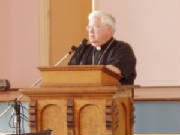 Pastor Buz Van Horne has served Trinity and later Redeemer for a total of 14 years. In 2010, he was joined by Rev. C. Thomas
Snapp, the current pastoral care specialist. He also spends considerable time in social ministry activities. Staff also includes
the able contributions of our organist Thomas Hall, secretary Diane Harrop, handbell choir director and cantor Shelley Cuthbertson,
and church sexton Azur H.Abdić. Pastor Buz Van Horne has served Trinity and later Redeemer for a total of 14 years. In 2010, he was joined by Rev. C. Thomas
Snapp, the current pastoral care specialist. He also spends considerable time in social ministry activities. Staff also includes
the able contributions of our organist Thomas Hall, secretary Diane Harrop, handbell choir director and cantor Shelley Cuthbertson,
and church sexton Azur H.Abdić.
THE FIRST TRINITY BUILDING
Derek Kilborn recently uncovered a panoramic picture of 1913 Saint Petersburg. In the right corner,
he discovered the original Trinity Lutheran building. The church was located at the corner of 5th Street
and 2nd Avenue South, now the site of the old YMCA. Thanks, Derek! You found a real treasure!
|

